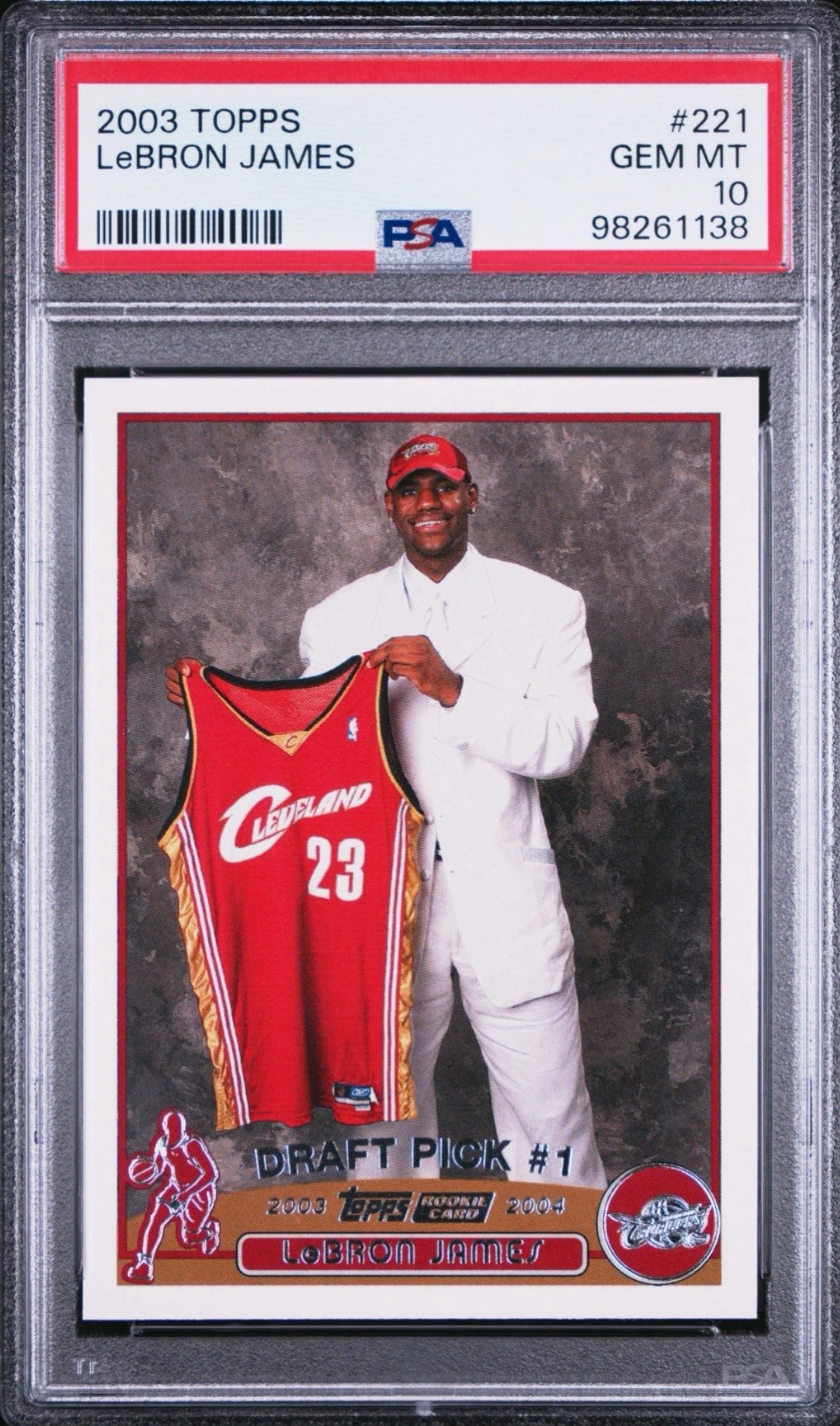In the shimmering kaleidoscope that is the sports card collecting world, few cards capture the imagination and steadfast appreciation of collectors like the 2003 Topps LeBron James rookie card, card number 221. It stands as a masterful testament to both vintage charm and modern design, straddling the transition from traditional paper to the glossy allure of chrome. The card doesn’t just bridge an era, it shapes the very heartbeat of what it means to be a collector in the digital age.
The 2003 Topps LeBron card isn’t necessarily the rarest bird in the gilded aviary of sports ollect—and indeed, there are flashier LeBron rookie cards that would make a magpie drool—but this card has a unique fiber. It’s the foundational cornerstone that taught many budding enthusiasts the art of collecting. A veritable lesson in the economics of supply and demand, it manages to balance availability across a range of grades while keeping interest buoyant enough to ensure the impeccable copies don’t sit unappreciated for long.
And if numbers are the language of passion, the stats tell all. By mid-August 2025, eBay auctions for the card’s PSA 10 grade (which speaks the language of mint condition with a distinctly posh accent) saw bids hanging consistently around the $2,000-$2,100 bracket. The arc of these transactions stayed gracefully steady, as indicated by hammer prices incrementally escalating through August—$2,000 on the 6th, $2,050 on the 9th, $2,076 and $2,030 on the 13th, and $2,175 by the 18th. Stable, predictable, almost like a metronome keeping time in this frenzied symphony of collectors and competitions.
Zoom out to a wider lens, and you find the market, represented by platforms like Card Ladder, echoing a similar tune. The PSA 10 card swung to a late-August sale of $2,531, only a whisper above eBay’s tempo but indicative of an upward trend that’s as gentle as it is comforting. Nothing ostentatious—just a steady climb supported by solid demand.
Topps, wise sages of the card realm, didn’t halt at the base card. Oh no. They adorned their 2003 crown jewel collection with alluring variations: the Black Border, capped at 500, the Gold at a sparing 99, and a First Edition showcasing the allure of scarcity sans serial numbering. Within these layered realms of rarity and opulence, these versions become the friends you keep meeting on price tools and set lists, each offering its narrative to the collector’s journey.
Then there’s the Topps Collection photo variation from the factory set—a whimsical cousin that plays a quieter game. With its own unique image and smaller footprint, the narrative pivots slightly. In gem mint condition, it may not scream as loudly as the base version, but it provides a detour for those building around the flagship core.
A keen eye on grading nuances reveals the real contours of this discussion. The PSA 10 populace may be healthier than a New Year’s resolution but still dances to the tune of a blue chip, rather than ethereal lore. And as is the collector’s ongoing conversation, the leap from PSA 9 to PSA 10 is more than just numerical—it’s psychological and fiscal. For those dipping their toes back into the pool of nostalgia, raw versions have cozied up to the $250-$300 lounge, while PSA 9s stretch into the high $400s territory. Within these shifting sands, centering and surface shine like guiding stars, while seller feedback serves as your trusty compass.
If your strategy involves dancing with the market metrics, your playbook is straightforward. Ride the waves of evening eBay auctions, see the cresting tides of PSA 10s hit the $2,000-$2,100 reefs, and brace for swells as bidding wars unleash.
The enduring debate of paper versus chrome in LeBron’s rookie class is somewhat like debating music from vinyl versus streaming. While chrome refractors preen with peacock-like panache, the paper Topps base evokes memories of binders and the satisfying scent of mid-2000s retail nostalgia. It offers a narrative—a story stretching across eras, echoing through time—a pivotal chapter in the hobby’s history across guides both aged and anew.
In a hobby where perfection is in the eye of the beholder, centering’s tight left rails and occasionally bulging black border nicks are the quirks that bring out the inner critic. The crisp-cornered, flawless PSA 10, when found, is a quiet epiphany—its charm in every discerning collector’s showcase lighting up like a priceless gem.
Different budgets paint different paths; you might adopt a strongly centered PSA 9 for enjoyment at about half the gem’s dollar label. A well-kept raw card holds the promise of a satisfying grade-and-hold adventure. And for fans of exclusivity, the First Edition caters to a thirst for distinction without scaling the Gold and Black heights. The choice is not about internet trend-chasing but matching your intrinsic collector’s essence with the card in hand.
Serendipity lives on, even today. Rip open the universe of Galaxy Rip Packs, and you might stumble across a 2003 Topps LeBron—an event orchestrated to offer real chase moments without brooding expectation. This curated magic rotates but exists, greeting lucky seekers with pure exhilaration that justifies the thrill of the rip.
Standing here in 2025, this card’s evaluation stands resilient beyond transient hype. Its qualifications are time-tested; its narratives cemented in the lore of collecting. As you glance at checklists, survey bids, and consider the wide-ranging collectors this card serves, it stands unwavering. Whether you tuck one away for posterity, negotiate for it at trade shows, or seek it by unraveling packs, few basketball cards lay such a reliable foundation for any collection. And should your collector’s path wander towards its rarer iterations—the Black, the Gold, or the First Edition—you remain tethered to the magnetizing sphere whose gravity holds the entire hobby in orbit.

